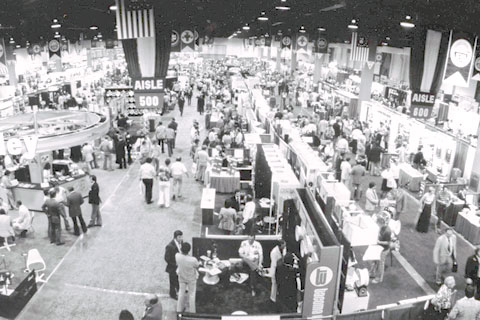SEMA News - June 2009
RESEARCH
By Ty Michael
Measuring Consumers’ Performance Parts and Accessories Purchase Intentions
 |
During these tough economic times, forecasting consumer spending helps to focus in on the road ahead. While not being a precise measure of future spending, the SEMA Performance Parts and Accessories Demand Index (PADI) provides marketing planners with a useful tool that estimates future specialty-equipment demand.
By tracking the index, industry experts have another piece of data that can help with planning inventories as well as how to spend those increasingly scarce marketing dollars.
From January–March 2009, consumers began to show some optimism about their future specialty-equipment purchase plans. Two of the three months showed increases in the SEMA index, followed by a March drop-off, as shown in Graph 1 (below). However, specialty-equipment sales are seasonal, so fluctuations in consumer purchase plans are to be expected. Last year, for example, the March index showed a similar decline after a February spike. Nevertheless, results for the SEMA index for the first quarter of this year averaged four points higher than in the last quarter of 2008—a sign that consumers are now thinking about opening their wallets and spending money on their vehicles. During January through March of this year, the PADI average came in at 36, a drop of 23 points from the same time last year, but higher than the late-2008 slump.
 |
|
| During March of this year, the SEMA Performance Parts and
Accessories Demand Index (PADI) reached 30, down 12 points from last
year. Overall, the index averaged 36 for the first quarter of 2009. |
Index Explained
After looking at the first-quarter index data, some readers may wonder what exactly the SEMA Performance Parts and Accessories Demand Index is. Simply put, it is a value that measures consumers’ purchase intentions for automotive specialty equipment. Every month, consumers are surveyed and asked about their specialty-equipment purchase intentions. Much like the highly watched consumer confidence index, which quantifies consumer optimism for the current state of the U.S. economy, the SEMA index measures whether consumers feel optimistic about spending money on modifications for their vehicles sometime within the following three months of each respective survey. This helps provide a rough forecast for demand of specialty equipment in the near future.
The SEMA PADI and its movement are projectable to the national market for specialty-equipment products, which consists of more than 114 million U.S. households. Each month, a random digit-dial telephone survey is used to collect the survey data in order to provide a nationally representative sample of U.S. consumers. Typically, the responses total between 850 and 1,000 in any given month. The margin of error is normally within the +/- 3%–4% range.
Although the SEMA index is not a precise measure of absolute future purchasing activity, it is nonetheless a tool for understanding and predicting industry sales. There are two ways of interpreting the index. First is its direction—whether the index is rising or falling. Second are the values themselves, which provide a year-over-year guide to the degree of change in consumer expectations for purchasing industry products.
 |
| Despite declines in overall purchase intentions, the data above does
provide some relief by showing specific demographics that are actually
holding steady, if not improving, on their possible future purchase
plans. |
The Latest Results
By product category, racing and performance products showed a slight uptick from the last quarter of 2008. During the first three months of this year, 6% of consumers surveyed, on average, said that they planned to purchase performance products, compared to 7% at this time last year. Four percent indicated accessory and appearance product purchase plans, which is a decline from 7% last year, while 5% said they plan to purchase wheel, tire and suspension products, down 6% from last year.
While these declines may seem daunting to companies eagerly awaiting signs of industry improvement, the data in Table 1 does provide some relief by showing specific demographics that are actually holding steady, if not improving, on their possible future purchase plans. For example, notice that 21% of consumers 18–24 years of age said that they planned to purchase racing and performance products during the first three months of this year, up to the same level at this time last year when the specialty-equipment industry was experiencing pre-recessionary growth levels.
Recent SEMA PADI results also show that consumers are slowly shifting away from general personalization and heading toward a niche-focused theme for their vehicle customization plans. Over the past three months, more consumers were eyeing the hot-rod, off-road and street-performance markets compared to this time last year, as shown in Table 2. When consumers planning specialty-equipment purchases were asked what form their vehicle would take after customization, the most common answer, on average over the last three months, was “general personalization” (43%), followed by “street performance” (15%) and “restoration” (13%). Although the most popular form of planned modifications is still restyling, more consumers are now deciding to head toward street-performance-, hot-rod- and off-road-type modifications.
 |
|
| Recent SEMA Performance PADI results also show that consumers are
slowly shifting away from general personalization and heading toward a
niche-focused theme for their vehicle customization plans. |
What the PADI Means to You
So now that all of this data has been presented, many readers are probably wondering how they can use the SEMA index data to make business decisions. SEMA members that have already used the index explain that matching up their individual sales data to the index trend line has helped to reaffirm that they are keeping pace with the market.
“I often use the PADI, which confirms our sales months when things were slow, from July to current,” said Bob Shymkiw, vice president of sales and marketing for TFP Inc., a manufacturer of stainless-steel chrome trim. Shymkiw also noted that it was reassuring to see that the index fluctuations—both peaks and valleys—were very similar to the sales trends his company experienced during the latter half of last year and the early part of this year.
Since the SEMA PADI has been measuring consumers’ purchase intentions for a couple of years now, trend analysis is also possible. For instance, if the PADI showed an upward trend after July 2008, then it is possible that a similar growth period could be expected after July of this year. The opposite could also be true, as noted by Ron Coleman, president of Competition Cams Inc., manufacturer of camshafts and valvetrain products.
“By studying the Performance Parts and Accessories Demand Index and performing trend analysis, I have a good idea of when to cut inventory levels,” he said, and noted that the index helps in looking forward and getting a sense of when business may improve as well as pinpointing specific age groups and geographic regions that are experiencing growth. “The ultimate goal of using any index, like that produced by SEMA, is to determine who will enter your shop to buy a product and when they will be making that transaction,” Coleman said.








